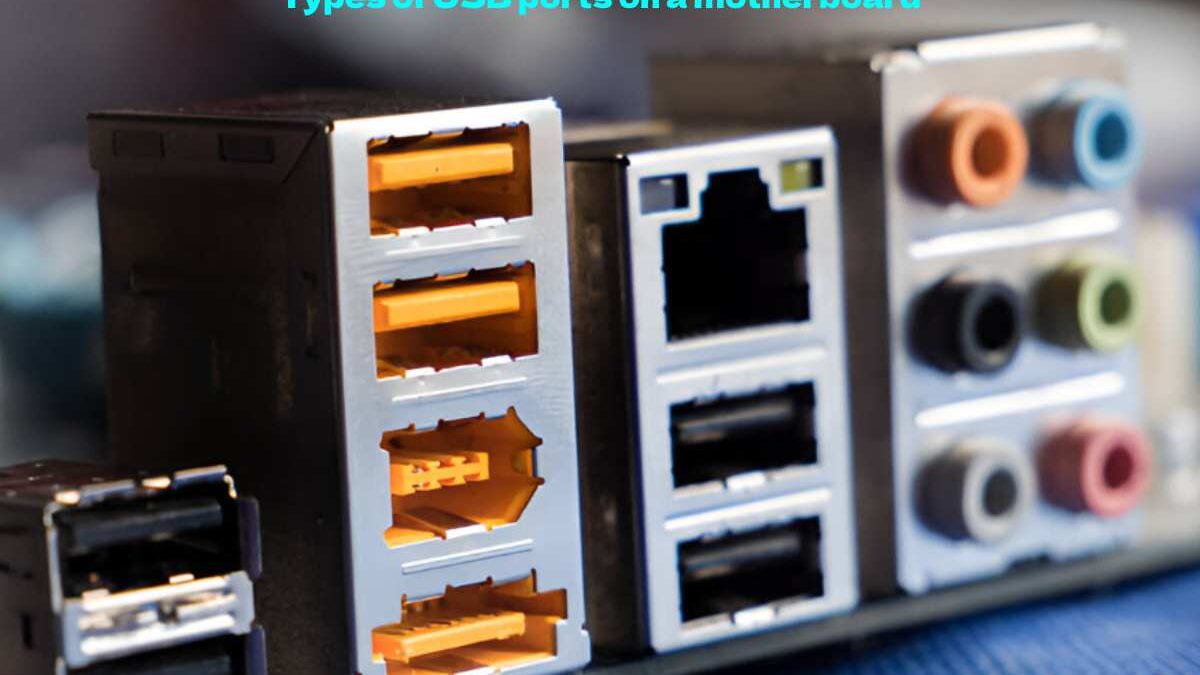Modern motherboards support a variety of USB ports, each designed for different speeds, power outputs, and device compatibility. From the basic USB 2.0 ports to high-speed USB 3.2 and USB-C connections, understanding these types is essential for building, upgrading, or troubleshooting a PC. Identifying the right USB port ensures optimal performance whether you’re connecting peripherals, charging devices, or transferring data.
Table of Contents
Types of USB ports on a motherboard
USB 1.1 Port (Legacy)on
- Ancient standard
- Data transfer speed up to 12 Mbps
- Rarely found on modern motherboards
- Mostly replaced by USB 2.0
- Used for low-speed peripherals like a mouse and keyboard
USB 2.0 Port
- Introduced in 2000
- Maximum speed: 480 Mbps
- Widely used for basic devices.
- Common black connectors
- 9-pin internal headers
- One-way communication
- Used for mice, keyboards, printers, and fans
- Low power output (2.5W)
- Still used in budget systems
USB 3.0 Port
- Released in 2008
- Also known as SuperSpeed USB
- Transfer speed up to 5 Gbps
- Blue connectors on the motherboard or I/O
- 19 or 20 pins in internal headers
- Dual-row header layout
- Backward compatible with USB 2.0
USB 3.1 Gen 2 Port
- Improved version of USB 3.0
- Speed up to 10 Gbps
- Commonly teal-colored port
- Also labelled SS10 (SuperSpeed 10 Gbps)
- Compatible with USB Type-A and Type-C
- Internal header with more bandwidth
- Found on modern gaming or premium boards
- Backwards compatible with USB 3.0 and USB 2.0
- Suitable for fast data transfers, SSDs
USB 3.2 Gen 1×1 and Gen 1×2
- Continuation of the USB 3.1 naming standard
- Gen 1×1 = 5 Gbps (like USB 3.0)
- Gen 1×2 = 10 Gbps (using dual-lane)
- Confusing naming, same connectors as USB 3.1
- Supported on newer boards
- Labelled clearly in technical specs
USB 3.2 Gen 2×1 and Gen 2×2
- Gen 2×1 = 10 Gbps
- Gen 2×2 = 20 Gbps
- Uses USB Type-C ports
- Delivers higher bandwidth
- Ideal for video, large file transfers
- Supports charging and video via USB-C
- Requires compatible devices and cables
- Ports are usually red or marked SS20
USB Type-C Port
- Introduced with USB 3.1 and later
- Reversible connector design
- Supports data, power, and video
- Internal header: 24-pin
- External port: slim oval shape
- Found on the latest boards and laptops
- Supports Power Delivery (PD) up to 100W
- Can replace HDMI, USB, and charging ports
- Used in MacBooks, Android, and monitors
- Requires a Type-E internal header on the motherboard
- May need adapters for older accessories
USB 4.0 Port
- Based on Thunderbolt 3
- Speed: Up to 40 Gbps
- Uses a USB-C connector
- Supports data, video (8K), and power
- Full backwards compatibility
- Requires a high-end motherboard
- Ideal for professionals and creators
- Labeled USB4 or TB4
- Provides PCIe tunnelling
- Supports daisy-chaining of devices
Thunderbolt Port (TB3 / TB4)
- Uses a USB-C connector
- Supports USB, DisplayPort, PCIe
- Speeds up to 40 Gbps
- Works with Thunderbolt and USB4 devices
- Supports high-res displays and eGPUs
- Premium boards only
- Labelled with lightning bolt symbol
- Requires a specific controller on board
USB Headers (Internal Ports)
USB 2.0 Header
- 9 pins
- Black plastic tab
- Found on almost all boards
- Connects to the front USB 2.0 ports
- Supports basic peripherals
USB 3.0 Header
- 19 or 20 pins
- Blue plastic tab
- Dual row
- Connects to the front USB 3.0 ports
- Higher data rate for modern devices
USB 3.1 / 3.2 Header
- Similar to 3.0 but higher speed
- May support USB-C front panel. Teal or turquoise in colour
- Marked “F_USB3_1” or “USB_E1”
- USB-C Internal Header (Type-E)
- 24-pin header
- Used for front-panel USB-C
- Requires a matching case connector
- Smaller and rectangular
- Usually near PCIe slots
Rear I/O USB Ports
- Mounted on back of motherboard
- Pre-attached to I/O shield
- Varies by model: USB 2.0, 3.0, 3.2, USB-C
- Color-coded for easy identification
- Often labeled as SS, SS10, SS20
- May include charging ports (yellow/red)

